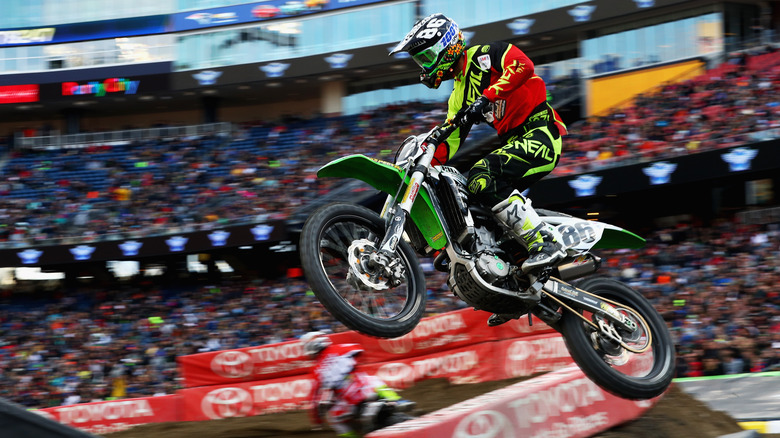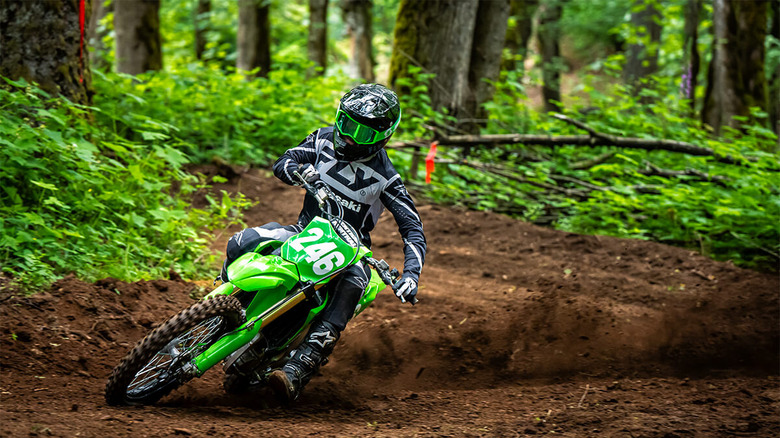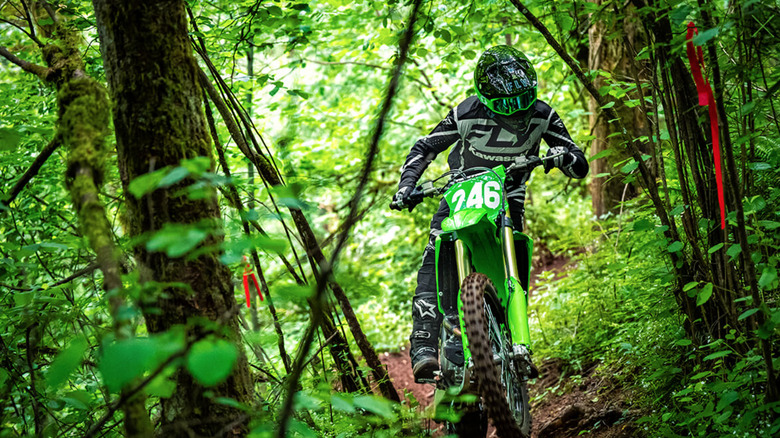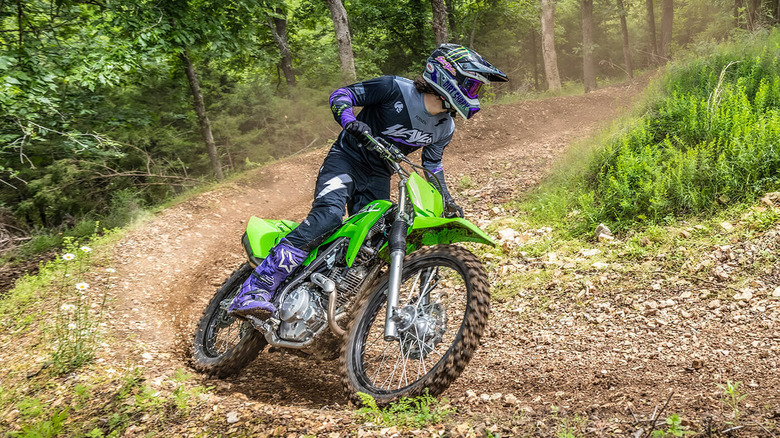What's The Difference Between Kawasaki MX And Cross Country Motorcycles?
In general, MX stands for a line of motorcycles designed to be used in motocross. In the beginning, Kawasaki followed this naming convention with the launch of the 1973 250MX and the 125MX. However, a year later, Kawasaki shifted and changed its motocross model names to start with KX instead. Since then, Kawasaki has used the KX nomenclature for its dirt bike series, which remains popular today.
Since then, several lines of the KX bikes have graced the racing scenes, like the youth-focused KX65, KX85, and the KX112. And, of course, Kawasaki also offers several full-size motocross bikes, such as the KX250. While not necessarily the fastest bike in the market, it still ranks pretty highly in our list of best Kawasaki bikes for trails. On the other hand, the KX450 and KX450SR models both used four-stroke engines that could pack a monstrous 449cc punch. Last year, Kawasaki released the latest cross-country versions of its beloved KX250 and KX450 dirt bikes as well, the KX250X and KX450X — but how exactly are they different?
Kawasaki's next generation motocross and cross-country bikes
Although it was initially released nearly two decades ago, the KX450 remains one of the most successful Kawasaki motorcycles in history. In 2024, Kawasaki launched the next generation of its beloved off-road motocross and cross-country bikes to much excitement. On the surface, the signature green and black combination can trick you into thinking they're all the same type of motorcycle, but discerning eyes may be able to spot slight differences in tuning that set them apart in important ways.
To increase its revolutions per minute (rpm) capabilities, the 2024 Kawasaki KX450 had some layout changes to make its valves more symmetrical with the exhaust ports. In an effort to make it lighter and easier to maneuver, Kawasaki also made efforts to move the muffler to the center and added an upgraded aluminum frame to support better traction control and sharper rear fenders. Lastly, it introduced relevant switch settings that could assist riders in adjusting power modes (normal or mild), Kawasaki Traction Control switch (off, weak, or strong), and launch control mode.
What's the difference between the Kawasaki KX250 and KX250X?
In recent times, Kawasaki released the latest additions to the series, the 2025 Kawasaki KX250 motocross and KX250X cross-country models. Both have the same 4-stroke, single-cylinder engine that can displace the same amount of horsepower. In addition, they both share the same fuel system, Digital DC-CDI ignition, 5-speed, return shift transmission, and even lime green color.
However, the KX250X sets itself apart in a few key ways. For example, the cross-country version has different tires (80/100-21 Dunlop AT81 for the front and 110/100-18 Dunlop AT81 for the back), which are better suited for the off-road requirements of mixed terrain. In terms of build, it comes with a shorter overall length, overall height, ground clearance, and seat height. With a heavier curb weight, it also has a sealed chain, optimized suspension settings, and, of course, a kickstand. Lastly, the 2025 KX 250 motocross version is slightly cheaper, with an MSRP of $8,999, while the 2025 KX250X cross-country model has an MSRP of $9,099.
Motorcross bikes and trail bikes: A tale of two thrill rides
On the surface, it may seem like motocross bikes and cross-country dirt bikes are pretty similar. After all, they're both designed for riders who love living on the wild side, plus a little hard landing every now and then. But to understand how they're different, we have to understand the challenges they're meant to help their riders overcome.
To start with, motocross bikes are designed to run on designated race tracks that are the equivalent of a risky obstacle course. While there's a variety of drops, turns, and jumps, the terrain is generally pretty predictable because it is a looped track specifically designed for that purpose. Because motocross as a sport requires being light on your feet (o,r in this case, your bike), it often has structural features to reduce weight, like having lighter frames, shorter suspensions, and a host of pre-race dirt bike rituals for managing the regular impact.
On the other hand, cross-country dirt bikes are designed for a different kind of racing experience. Typically, cross-country bikes often travel through relatively fewer man-made obstacles and are meant to run on more unpredictable ground (literally). For example, cross-country riders should be prepared for longer rides on different surfaces that enclosed track drivers don't have to think about, like tree roots or gravel.
If you need some inspiration for your next off-road adventure with your Kawasaki bike, you can take time to view the most impressive motorcycle stunts in movies. That said, if you're looking to try some Kawasaki motorcycles with jaw-dropping power, there are plenty of models that can go over 200HP that should be on your list instead.



